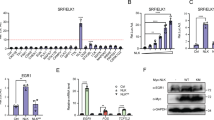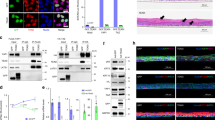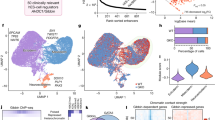Abstract
IκB kinase-α (IKK-α)1 exhibits protein-kinase-dependent and -independent functions. Its kinase activity is required for lymphoid organogenesis2 and mammary gland development3, whereas a kinase-independent activity is required for epidermal keratinocyte differentiation4. In addition to failed epidermal differentiation, IKK-α-deficient mice exhibit abnormal skeletal and craniofacial morphogenesis4,5,6. As similar defects are not exhibited by mice that experience systemic inhibition of NF-κB7, we postulated that the morphogenetic defects in IKK-α-deficient mice are not caused by reduced NF-κB activity but instead are due to failed epidermal differentiation that disrupts proper epidermal–mesodermal interactions. We tested this hypothesis by introducing an epidermal-specific Ikka (also known as Chuk) transgene into IKK-α-deficient mice. Mice lacking IKK-α in all cell types including bone and cartilage, but not in basal epidermal keratinocytes, exhibit normal epidermal differentiation and skeletal morphology. Thus, epidermal differentiation is required for proper morphogenesis of mesodermally derived skeletal elements. One way by which IKK-α controls skeletal and craniofacial morphogenesis is by repressing expression of fibroblast growth factor (FGF) family members, such as FGF8, whose expression is specifically elevated in the limb bud ectoderm of IKK-α-deficient mice.
This is a preview of subscription content, access via your institution
Access options
Subscribe to this journal
Receive 51 print issues and online access
$199.00 per year
only $3.90 per issue
Buy this article
- Purchase on Springer Link
- Instant access to full article PDF
Prices may be subject to local taxes which are calculated during checkout





Similar content being viewed by others
References
DiDonato, J. A., Hayakawa, M., Rothwarf, D. M., Zandi, E. & Karin, M. A cytokine-responsive IκB kinase that activates the transcription factor NF-κB. Nature 388, 548–554 (1997)
Senftleben, U. et al. Activation by IKKα of a second, evolutionary conserved, NF-κB signaling pathway. Science 293, 1495–1499 (2001)
Cao, Y. et al. IKKα provides an essential link between RANK signaling and cyclin D1 expression during mammary gland development. Cell 107, 763–775 (2001)
Hu, Y. et al. IKKα controls formation of the epidermis independently of NF-κB via a differentiation inducing factor. Nature 410, 710–714 (2001)
Takeda, K. et al. Limb and skin abnormalities in mice lacking IKKα. Science 284, 313–316 (1999)
Li, Q. et al. IKK1-deficient mice exhibit abnormal development of skin and skeleton. Genes Dev. 13, 1322–1328 (1999)
Schmidt-Ullrich, R. et al. Requirement of NF-κB/Rel for the development of hair follicles and other epidermal appendices. Development 128, 3843–3853 (2001)
Hu, Y. et al. Abnormal morphogenesis but intact IKK activation in mice lacking the IKKα subunit of the IκB kinase. Science 284, 316–320 (1999)
Wessells, N. K. Tissue Interactions and Development (Benjamin-Cummings, Menlo Park, California, 1997)
Vassar, R., Rosenberg, M., Ross, S., Tyner, A. & Fuchs, E. Tissue-specific and differentiation-specific expression of a human K14 keratin gene in transgenic mice. Proc. Natl Acad. Sci. USA 86, 1563–1567 (1989)
Torrey, T. W. Morphogenesis of the Vertebrates 275–308 (Wiley, New York, 1970)
Takahashi, H., Shikata, N., Senzaki, H., Shintaku, M. & Tsubura, A. Immunohistochemical staining patterns of keratins in normal oesophageal epithelium and carcinoma of the oesophagus. Histopathology 26, 45–50 (1995)
Delhase, M., Hayakawa, M., Chen, Y. & Karin, M. Positive and negative regulation of IκB kinase activity through IKKβ subunit phosphorylation. Science 284, 309–313 (1999)
Zandi, E., Chen, Y. & Karin, M. Direct phosphorylation of IκB by IKKα and IKKβ: Discrimination between free and NF-κB-bound substrate. Science 281, 1360–1363 (1998)
Dudley, A. T. & Tabin, C. J. Constructive antagonism in limb development. Curr. Opin. Genet. Dev. 10, 387–392 (2000)
Solloway, M. J. et al. Mice lacking Bmp6 function. Dev. Genet. 22, 321–339 (1998)
Yi, S. E., Daluiski, A., Pederson, R., Rosen, V. & Lyons, K. M. The type I BMP receptor BMPRIB is required for chondrogenesis in the mouse limb. Development 127, 621–630 (2000)
Zou, H. & Niswander, L. Requirements for BMP signaling in interdigital apoptosis and scale formation. Science 272, 738–741 (1996)
Winnier, G., Blessing, M., Labosky, P. A. & Hogan, B. L. Bone morphogenetic protein-4 is required for mesoderm formation and patterning in the mouse. Genes Dev. 9, 2105–2116 (1995)
Webster, M. K. & Donoghue, D. J. FGFR activation in skeletal disorders: too much of a good thing. Trends Genet. 13, 178–182 (1997)
Martin, G. R. The roles of FGFs in the early development of vertebrate limbs. Genes Dev. 12, 1571–1586 (1998)
Kawakami, Y. et al. MKP3 mediates the cellular response to FGF8 signalling in the vertebrate limb. Nature Cell Biol. 5, 513–519 (2003)
Minowada, G. et al. Vertebrate Sprouty genes are induced by FGF signaling and can cause chondrodysplasia when overexpressed. Development 126, 4465–4475 (1999)
Zuniga, A., Haramis, A. P., McMahon, A. P. & Zeller, R. Signal relay by BMP antagonism controls the SHH/FGF4 feedback loop in vertebrate limb buds. Nature 401, 598–602 (1999)
Mohammadi, M. et al. Structures of the tyrosine kinase domain of fibroblast growth factor receptor in complex with inhibitors. Science 276, 955–960 (1997)
Yamamoto, Y. et al. A nucleosomal role of IKKα is critical for cytokine-induced activation of NF-κB regulated genes. Nature 423, 655–659 (2003)
Welscher, P. et al. Progression of vertebrate limb development through SHH-mediated counteraction of GLI3. Science 298, 827–830 (2002)
Martin, J. F., Bradley, A. & Olson, E. N. The paired-like homeo box gene MHox is required for early events of skeletogenesis in multiple lineages. Genes Dev. 9, 1237–1249 (1995)
Wilkinson, D. G. In Situ Hybridization (Oxford Univ. Press, Oxford, 1993)
Chen, L.-W. et al. The two faces of IKK and NF-κB inhibition: Prevention of systemic inflammation but increased local injury following intestinal ischemia-reperfusion. Nature Med. 9, 575–581 (2003)
Acknowledgements
We thank A. Ullrich for the FGF receptor inhibitor (SU5402), T. Kato, M. Delhase and S. Roy for technical assistance and discussions, and M. Ellisman and M. Mackey for the election microscopy performed at the National Center for Microscopy and Imaging Research. Work was supported by grants from the National Institutes of Health, and Superfund Basic Research Program and CERIES research awards.
Author information
Authors and Affiliations
Corresponding author
Ethics declarations
Competing interests
The authors declare that they have no competing financial interests.
Supplementary information
Supplementary Figure 1
Comparison of transgenic hIKKα (tg IKKa ) expression with that of endogenous mIKKα. (PDF 23 kb)
Supplementary Figure 2
CK14-Ikka is not expressed in the esophagus. (PDF 164 kb)
Supplementary Figure 3
Defective epidermal differentiation of Ikka-/-mice is rescued by a CK14-Ikka(KM) transgene. (PDF 149 kb)
Supplementary Figure 4
The limbs and skeletal defects of Ikka-/- mice are rescued by CK14-Ikka transgene. (PDF 75 kb)
Supplementary Figure 5
The defect in craniofacial morphogenesis of Ikka-/- mice is rescued in Ikka-/-CK14-Ikka or Ikka-/-CK14-Ikka(KM) mice. (PDF 165 kb)
Supplementary Figure 6
FGF expression is reduced during keratinocyte differentiation. (PDF 196 kb)
Rights and permissions
About this article
Cite this article
Sil, A., Maeda, S., Sano, Y. et al. IκB kinase-α acts in the epidermis to control skeletal and craniofacial morphogenesis. Nature 428, 660–664 (2004). https://doi.org/10.1038/nature02421
Received:
Accepted:
Issue Date:
DOI: https://doi.org/10.1038/nature02421
This article is cited by
-
A novel lineage of osteoprogenitor cells with dual epithelial and mesenchymal properties govern maxillofacial bone homeostasis and regeneration after MSFL
Cell Research (2022)
-
Targeting HECTD3-IKKα axis inhibits inflammation-related metastasis
Signal Transduction and Targeted Therapy (2022)
-
The inflammatory kinase IKKα phosphorylates and stabilizes c-Myc and enhances its activity
Molecular Cancer (2021)
-
Basal and IL-1β enhanced chondrocyte chemotactic activity on monocytes are co-dependent on both IKKα and IKKβ NF-κB activating kinases
Scientific Reports (2021)
-
Inducible knockout of CHUK/IKKα in adult chondrocytes reduces progression of cartilage degradation in a surgical model of osteoarthritis
Scientific Reports (2019)
Comments
By submitting a comment you agree to abide by our Terms and Community Guidelines. If you find something abusive or that does not comply with our terms or guidelines please flag it as inappropriate.



